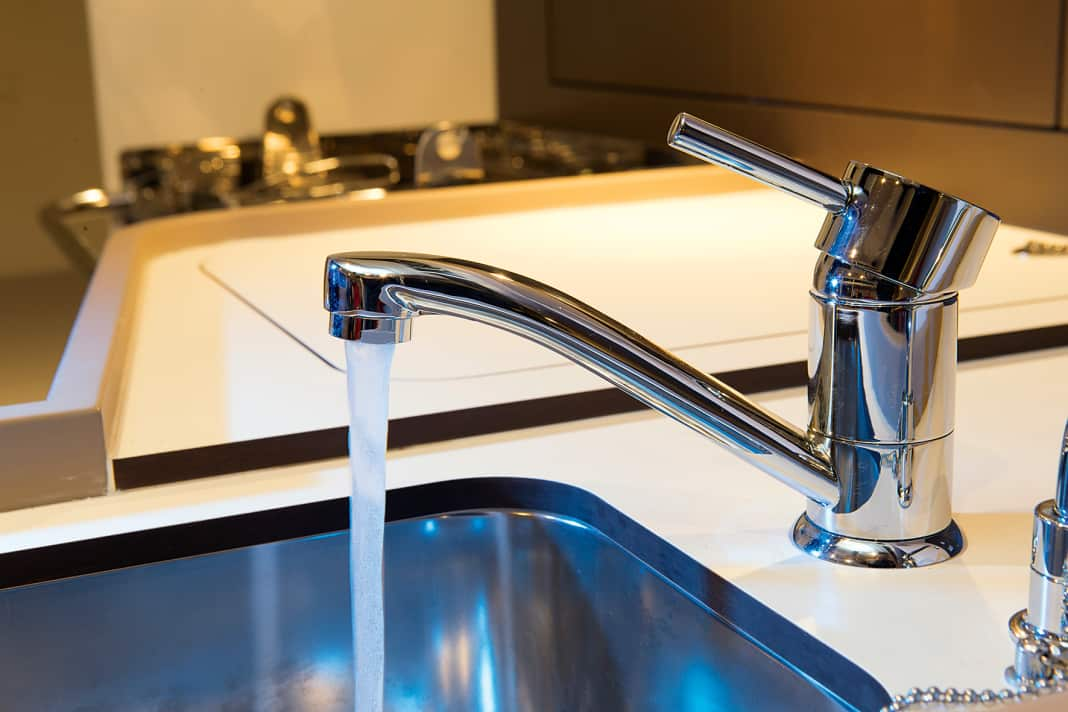





Although hand and foot pumps still exist for manually supplying drinking water on boats, these days they are usually only used as emergency pumps. In the event of a power failure, they still provide access to water from the drinking water tank. However, the modern standard is electrically operated pumps. These provide a water pipe-like installation on board, which supplies both cold and hot water and supplies several tapping points in the galley, in the bathroom, in the shower and at the outdoor shower on the bathing platform. Sometimes the flushing of the electric toilet is also connected to the drinking water system.
There are a few things to consider when selecting the components for a pressurised water system.
That is also interesting:
The pump for the pressurised water system
Diaphragm pumps are used for most pressurised water systems today. The impeller pumps that used to be used for fresh water supply are hardly used anymore due to one major disadvantage: they are not safe to run dry. The water tank can run dry, especially during the journey, but the pump continues to run without the crew noticing. This would quickly damage a rubber impeller.
In general, three main types of pumps are used on boats today:
1. pressure pumps without built-in pressure switch:
These pumps require a separate pressure switch, which must be installed in the pipework. Although this increases the installation effort and costs, it has the advantage that a defective pressure switch, the most common fault in drinking water systems on boats, does not immediately require the entire pump to be replaced. This can make repairs easier and cheaper.
2. pressure pumps with integrated pressure switch:
These pumps switch off automatically when the maximum set pressure is reached and restart when the pressure drops. It is recommended to integrate a pressure equalisation tank to compensate for pressure fluctuations and avoid switching on the pump unnecessarily. A larger equalising tank improves the function, even if space on board is often limited.
3. pressure pumps with electronic control and variable speed:
These pumps are more expensive and do not require an additional pressure equalisation tank. Water extraction can take some getting used to at first, especially when showering, as the water flow can be uneven. On the whole, however, these pumps work reliably and are practical.
Rubber feet and filter
Regardless of the pump type, most pumps in a pressurised water system are mounted on rubber bearings to minimise structure-borne noise. If you want the pump to be completely silent, you can install it in an insulated housing. However, ensure sufficient heat dissipation, especially for longer operating times. In addition, the fastening screws should not be overtightened so that the rubber bearings can develop their damping effect. Installing a dirt filter upstream of the pump protects the diaphragms and extends their service life; some devices are supplied with a filter.
It is recommended to install the fresh water pump of a pressurised water system as close as possible to the tank, ideally at the lower water outlet. Although many pumps are self-priming, the pressure build-up is much easier if the water is already present close to the pump. A faster pressure build-up also makes it easier to restore the water supply when the system is put back into operation after a long break.
Electrics of the pressurised water system
The correct cable cross-section is also important to ensure optimum performance. A cable that is too thin can lead to voltage losses, as a result of which the pump will not develop its full power. The operating instructions usually provide precise information on the required cable cross-sections. The pressurised water pump should always be supplied with power via its own fuse or an automatic circuit breaker.
When replacing the water-bearing hoses or pipes, you should always choose larger pipe cross-sections to ensure a sufficiently high water pressure, for example in the rear shower. In addition, radial bends should be used wherever possible instead of sharp angles to avoid unnecessarily obstructing the flow of water. Commercially available hoses or plastic pipes suitable for drinking water, which are available in DIY stores or specialised shops, are suitable for the installation.
Hot water thanks to boiler
When selecting a boiler, care should be taken to ensure that it can be operated both by the motor (in operation) and via a built-in 230-volt heating element when connected to shore power. This ensures that there is always enough hot water available. A well-insulated boiler ensures efficient heat storage. If the fresh water tank is too small, a larger boiler can increase the total fresh water supply if space permits.
An additional mixing valve, which unfortunately is often only available as an extra, can help to regulate the water temperature to a safe temperature after leaving the boiler. Such mixing valves can be retrofitted to existing systems.
Finally, it makes sense to install drain taps at the lowest points of the pipework. This makes it easier to drain the system before winterisation and protects against frost damage.
You can get the materials you need from boat chandlers such as www.svb.de.

